
The troops to the rescue... Don't believe all you see or hear about our military!! It is even better than you would be lead to believe... Maybe you will notice the availablity of the National Guard also...
Date: 12/18/2007 7:43:06 PM ( 17 y ago)
|
Most Popular
|
|
||||
|
|
||||
|
|
||||
|
|
SAN DIEGO - A teenager whose appendix ruptured at sea, hundreds of miles from help, got safely to shore Tuesday after an unusual rescue in which the Navy airlifted her from a cruise ship for emergency surgery.
Laura Montero, 14, fell ill aboard the Dawn Princess cruise ship off the coast of Baja California. The Bahamian-registered ship sent out a distress call Friday that was answered by the USS Ronald Reagan, which was on training maneuvers about 500 miles away.
The nuclear carrier was the closest ship with a hospital facility, according to a news release from the Navy. It steamed overnight toward the cruise ship, which was about 250 miles northwest of Cabo San Lucas when the call went out.
Then this newsletter from: http://www.simplytruth.com...
More truth on what really happened!!
In the recent wild fires in Calif. according to certain politicians from one of the major political parties, ( hint starts with Demo... ) You were led to believe because of the conflict in the Mideast that there was not any help from the military... This same type false info was put out about the Tornado damage to the town in the mid west; and so forth...
Here is some truth so you can see who is doing what... HUH!!
You can believe who and what you want, but for me I believe the truth; and want to thank those who offered support; and give them a BIG THANKS!!!
PHOTO LOG: The Wildfires of October
More than 400 military families from San Diego County and the surrounding areas took refuge from the wildfires that struck several San Diego communities in late October.
An estimated half-million people were urged to flee their homes across Southern California as wildfires blown by fierce, dry desert gusts -- known as Santa Ana Winds -- raced over the landscape with terrifying speed, destroying hundreds of structures, clogging highways with fleeing evacuees, and sent smoke and ash over a wide area.
Combat photographers from all branches documented America's military response to the disaster.
The HOIST is proud to share these images with our readers as a salute to their efforts.
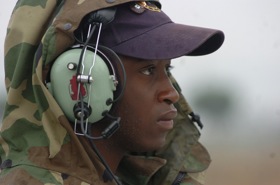
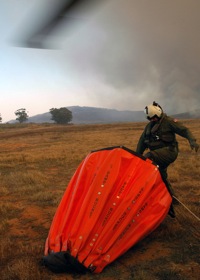
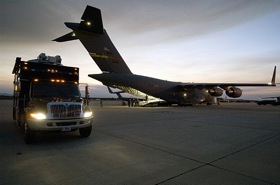 A USAF C-17 Globemaster III, from the 452nd Air Mobility Wing at March Air Reserve Base, CA, unloads Soldiers and equipment from the 5th Army Operational Command Post Two, from Ft. Sam Houston in San Antonio, TX. The Army command post unit deployed as part of a federal support package to assist federal, state and local agencies responding to the California wildfires.
A USAF C-17 Globemaster III, from the 452nd Air Mobility Wing at March Air Reserve Base, CA, unloads Soldiers and equipment from the 5th Army Operational Command Post Two, from Ft. Sam Houston in San Antonio, TX. The Army command post unit deployed as part of a federal support package to assist federal, state and local agencies responding to the California wildfires.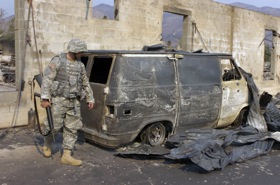 Looking much like a scene from Iraq, a soldier from the California Army National Guard patrols in a Valley Center, CA neighborhood where buildings and vehicles were destroyed in October's wildfires. More than 1,500 Army National Guard soldiers, along with Air National Guard and Air Force airmen, Sailors and Marines assisted civilian authorities in tackling the blazes that raged in San Diego County.
Looking much like a scene from Iraq, a soldier from the California Army National Guard patrols in a Valley Center, CA neighborhood where buildings and vehicles were destroyed in October's wildfires. More than 1,500 Army National Guard soldiers, along with Air National Guard and Air Force airmen, Sailors and Marines assisted civilian authorities in tackling the blazes that raged in San Diego County. 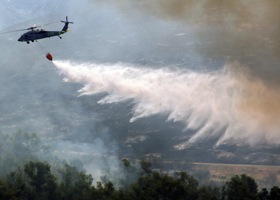
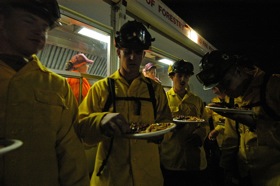 Seabees attached to Amphibious Construction Battalion (ACB) 1, grab a quick hot meal at a California Department of Forestry and Fire Protection (CalFire) base camp while helping to fight the wildfires. ACB-1 Sailors worked side-by-side with civilian firefighters from CalFire and other agencies in Hauser Canyon, constructing firebreaks to safeguard the town of Campo, CA.
Seabees attached to Amphibious Construction Battalion (ACB) 1, grab a quick hot meal at a California Department of Forestry and Fire Protection (CalFire) base camp while helping to fight the wildfires. ACB-1 Sailors worked side-by-side with civilian firefighters from CalFire and other agencies in Hauser Canyon, constructing firebreaks to safeguard the town of Campo, CA. 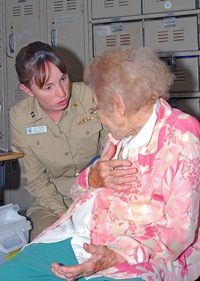
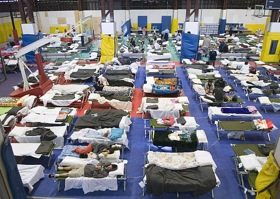
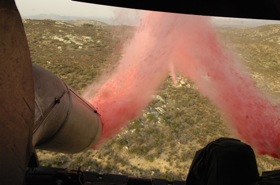 Phos-Chek fire retardant streams from a C-130 Hercules over the Witch Creek fire north of San Diego, CA. The C-130, equipped with the Modular Airborne Firefighting System (MAFFS) and its crew are assigned to the 302nd Airlift Wing from Peterson Air Force Base, CO. Fire retardants, like Phos-Chek and Fire-Trol, contain wetting agents, preservatives, rust inhibitors and colored red with ferric oxide to mark where they have been dropped. Once the fire is extinguished, the retardant acts as a fertilizer, which encourages plant regrowth.
Phos-Chek fire retardant streams from a C-130 Hercules over the Witch Creek fire north of San Diego, CA. The C-130, equipped with the Modular Airborne Firefighting System (MAFFS) and its crew are assigned to the 302nd Airlift Wing from Peterson Air Force Base, CO. Fire retardants, like Phos-Chek and Fire-Trol, contain wetting agents, preservatives, rust inhibitors and colored red with ferric oxide to mark where they have been dropped. Once the fire is extinguished, the retardant acts as a fertilizer, which encourages plant regrowth.
Popularity: message viewed 2884 times
URL: http://www.curezone.org/blogs/fm.asp?i=1065803
<< Return to the standard message view
Page generated on: 11/26/2024 7:51:25 AM in Dallas, Texas
www.curezone.org